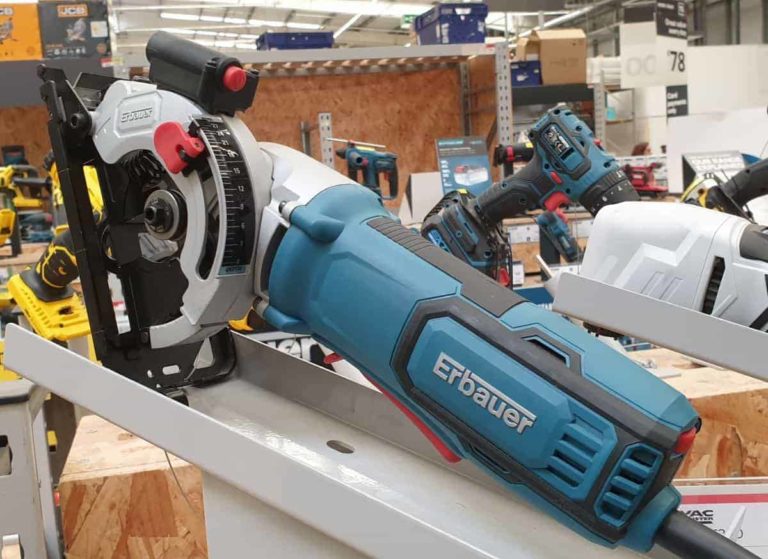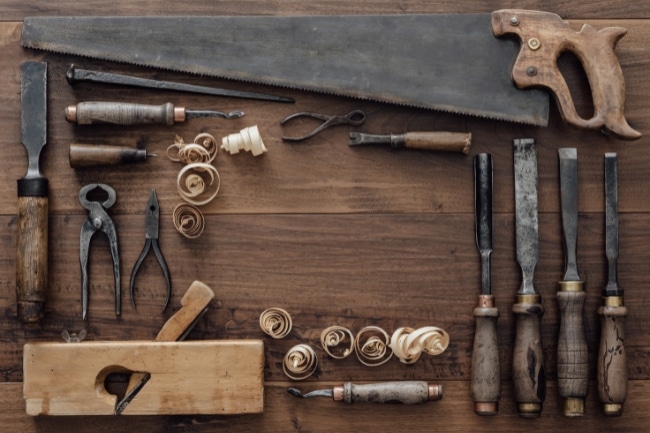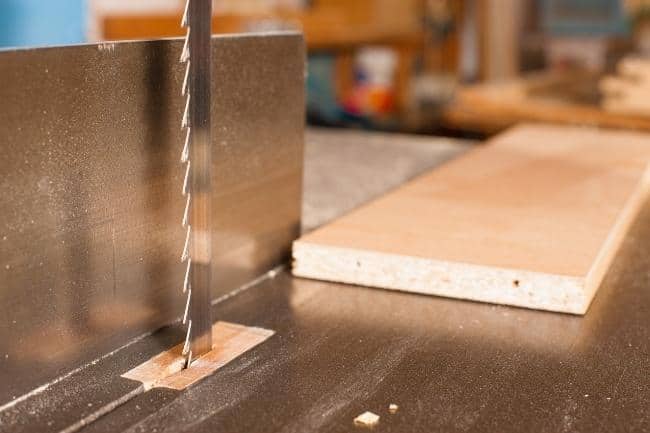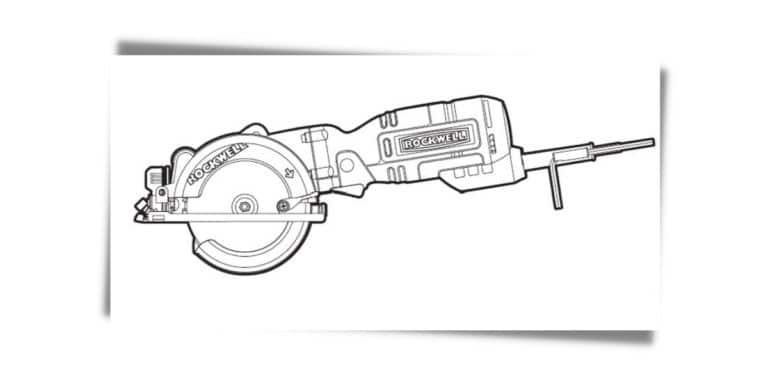Crafting Dreams from Scratch: Introduction to Woodworking Tools for Beginners
This post includes affiliate links. If you decide to make a purchase through my link, I might get a small commission for it at no additional cost to you. Thank you for supporting Upcycle This DIY That!
Woodworking can be a gratifying hobby, allowing you to create functional and beautiful furniture or home decor pieces for your home or even turn it into a fulfilling career. But starting out in woodworking can be a little intimidating, especially when faced with the vast array of tools and techniques available.
Fear not, because I’m here to help you navigate the world of woodworking tools and get you on your way to creating your very own masterpieces!
As a self-taught DIY-er and woodworker, I know firsthand how overwhelming it can be to begin this journey. That’s why I’ve dedicated my blog to helping you, whether you’re new to woodworking or looking to level up your skills.
By sharing my tips and suggestions that have worked for me over the years, we’ll build a strong foundation for your woodworking passion. Whether you’re a beginner or someone with some experience under your belt, this introduction to woodworking tools will serve as a helpful guide to get you started on your journey. So grab your safety goggles, and let’s dive in!
Importance of Understanding and Choosing the Right Tools
The key to mastering woodworking lies in understanding the vast assortment of tools that you have available at your disposal. Each tool has a distinct role, and choosing the right one can make the difference between a masterful piece and a mediocre project.
Identifying the ideal tool for a task is akin to selecting the right word for a sentence – it brings clarity, precision, and an overall elevation of your work.
Fundamentals of Woodworking Tools
Distinguishing Hand Tools and Power Tools
Hand tools and power tools form the yin and yang of woodworking. Hand tools, the traditional stalwarts, offer control and a direct connection to your work. They are quiet, portable, and essential for fine adjustments.
Power tools, on the other hand, provide speed and convenience. They expedite larger jobs, offer clean cuts, and can be potent when handled with skill.
Safety First: The Golden Rule of Working with Woodworking Tools
Regardless of the tools you wield, safety must always be paramount. The maxim, “a workman is only as good as his tools,” holds an essential caveat – a safe workman can make full use of his tools.

Understanding each tool’s potential hazards, wearing appropriate safety gear, and maintaining a clean workspace are the foundation of every successful woodworking project.
Safety Tools
Safety should always be the priority, especially when dealing with woodworking equipment. So let me share with you some essential safety tools that I’ve found indispensable in my own woodworking space:
> Safety glasses
Protecting your eyes from wood chips, dust, and debris while working with tools is crucial. Always wear safety glasses when operating any woodworking equipment.
> Hearing protection
Power tools, such as saws and sanders, can be loud and cause hearing damage over time. Invest in good earmuffs or earplugs to protect your ears from the noise.
> Dust mask or respirator

Wood dust can be harmful when inhaled, so it’s essential to wear a dust mask or respirator when working with wood, particularly when sanding or cutting.
> Proper footwear
Closed-toe shoes made from sturdy materials are essential when working in a woodworking shop. This will help protect your feet from falling tools, heavy objects, and sharp debris.
> Gloves
Wearing suitable gloves can help protect your hands from cuts, abrasions, and splinters. However, remember that gloves should not be worn when using specific power tools, as they could get caught and cause injury.
> Push sticks and feather boards
These tools help you maintain a safe distance from the cutting edges of saw blades and router bits. They also provide a means of controlling the workpiece, ensuring accurate cuts, and minimizing the risk of accidents.
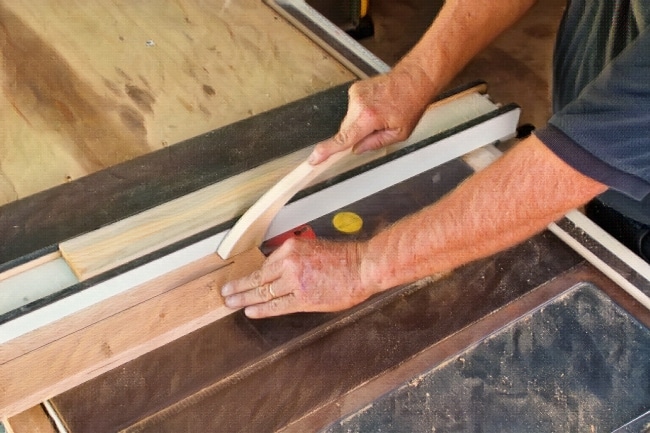
> Anti-fatigue mats
Not a safety tool per se, but these mats can significantly improve your comfort level and reduce fatigue when standing for long periods in your woodworking shop.
By incorporating these safety tools in your workspace, you can enjoy your woodworking projects while minimizing the risk of accidents and injury. Remember, no project is worth sacrificing your safety. So, always prioritize safety in your woodworking shop and work with care and caution.
Getting Started: Essential Hand Tools for Woodworking
As a beginner in woodworking, you’ll soon find that hand tools are essential for creating precise, high-quality projects. Let’s explore some of the most commonly used hand tools and how they can benefit your woodworking journey.
Making the Cut: Introducing Saws
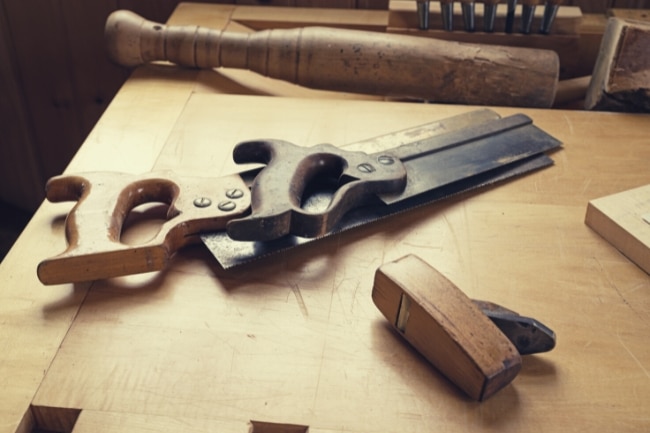
Hand saws are the backbone of your woodworking arsenal. Their long, thin blades, often with a wooden handle at one end, are ideal for making rough dimensioning cuts.
They come in different types, such as crosscut saws for cutting across the wood grain and rip saws for cutting with the grain. Other popular hand saws called back saws, known for their rigid spine along the top of the blade, offer precision. Perfect for joinery work like cutting tenons or dovetails.
Coping saws, on the other hand, with their thin blades and U-shaped frame, excel at cutting curves and intricate patterns. They are your artist’s brush in the woodworking canvas.
Measuring and Marking Tools: Precision at Its Best
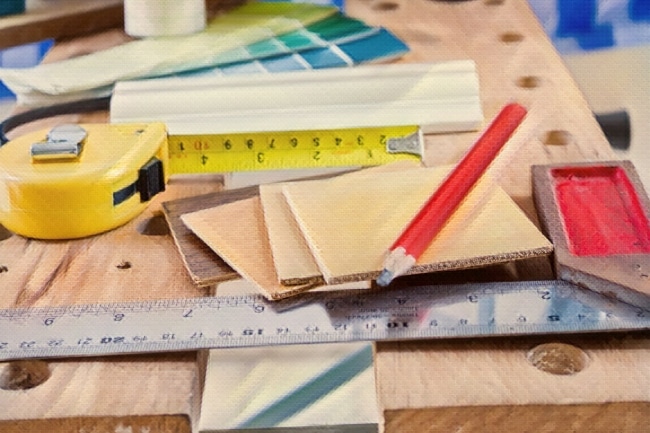
Tape Measures and Folding Rules
These are your standard tools for measuring length. They ensure your pieces fit together flawlessly.
A tape measure is an essential tool for any DIY-er or woodworker. To ensure you get the most out of your tape measure, it’s recommended to opt for a heavy-duty, retractable tape that can measure up to 25 feet or more.
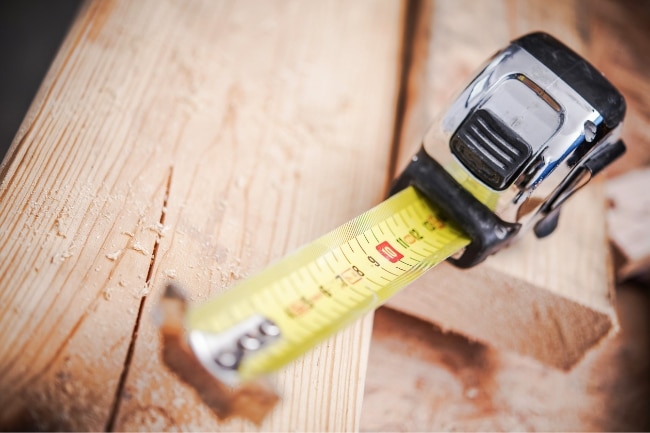
This will allow you to easily measure the lengths, widths, and heights of any furniture, room layouts, or woodworking projects you’ll be working on. It’s also a good idea to keep one in your pocket for quick measurements when you’re on the go.
Having a reliable tape measure at your fingertips will save you time and frustration in the long run and make your projects much easier to tackle.
Rulers come in various lengths and materials, like metal or plastic, and are perfect for marking precise measurements on your wood pieces. Of course, a reliable 12-inch ruler will be super helpful, but it’s also essential to have a longer one available when working on bigger pieces.
Marking Gauges
As a woodworker, you’ll need some practical marking tools, and that’s where marking knives come in handy. With their sharp blades and fine tips, these knives create precise lines that won’t fade or smear. As a result, you’ll find that your cuts are more accurate when using marking knives to lay out your work.
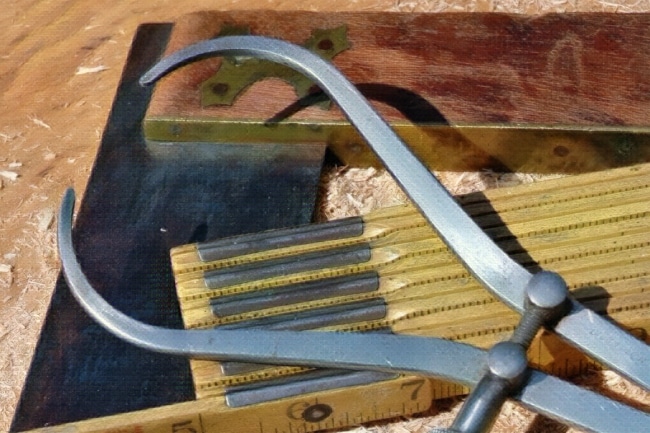
Last, some good ol’ graphite pencils will never go out of style for woodworking. Invest in a set of quality pencils with a comfortable grip that hones to a micro-fine point, making your markings more precise. Bonus tip: Keep a pencil sharpener close by to sharpen your pencils as needed during your projects quickly.
A compass or dividers can be a lifesaver when dealing with curved cuts or intricate designs. These tools help you lay out circles or arcs and precisely space holes or lines along your project’s surface.
Lastly, don’t overlook the importance of a good straightedge. As you work on your projects, you’ll often need to draw straight lines or check the flatness of a surface. A reliable straightedge will enable you to do both.
Squares and Bevels
Squares are crucial for making perfectly straight lines or right angles. Combination squares and speed squares are popular choices. Combination squares have a ruler with an adjustable head, which lets you set up perfectly angled lines or set the depth of a cut. Speed squares are triangular, allowing you to make right angles quickly.
In addition to a combination square, a sliding bevel is essential for marking angles that aren’t 90 or 45 degrees. With its adjustable blade, this tool enables you to transfer and duplicate angles onto your workpiece accurately.
Shaping and Finishing: Files, Rasps, and Chisels
Understanding Files and Rasps
Files and rasps are essential for shaping and refining your woodwork. They remove small amounts of material and smooth out edges or curves. Files offer a fine level of control when working on delicate details or narrow spaces.
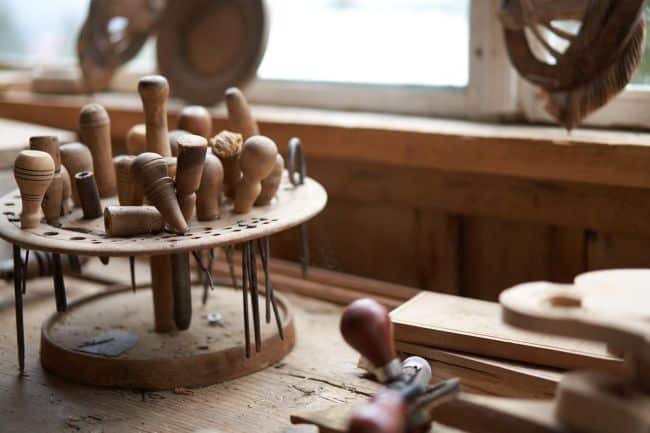
Rasps, on the other hand, have a coarser texture for quickly removing more material. Both tools help you achieve a refined and professional finish.
The Art of Using Chisels
Chisels are the sculptor’s tool, paring away the wood with accuracy and leaving a smooth surface behind. They are essential for creating precise joinery and shaping and carving wood. They come in various sizes and types, each designed for specific tasks. When using chisels, make sure to keep them sharp for accurate cuts.
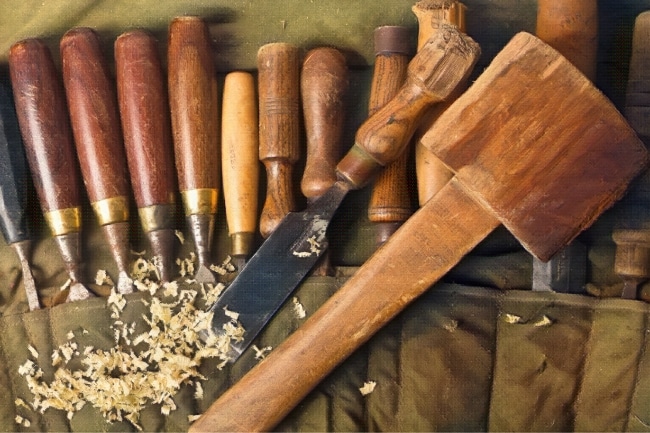
To work effectively with chisels, you’ll need a mallet. A mallet is a wooden hammer used to strike the chisel’s handle, providing enough force to make clean cuts without damaging the chisel handle. Having a quality mallet ensures a comfortable and controlled woodworking experience.
Refining Surfaces: Sanding Blocks and Hand Planers
Mastering Sanding Blocks
Sanding blocks may seem elementary, but they’re critical in any woodworking toolkit. Essentially a flat block that holds sandpaper, these devices allow for manual, controlled sanding.
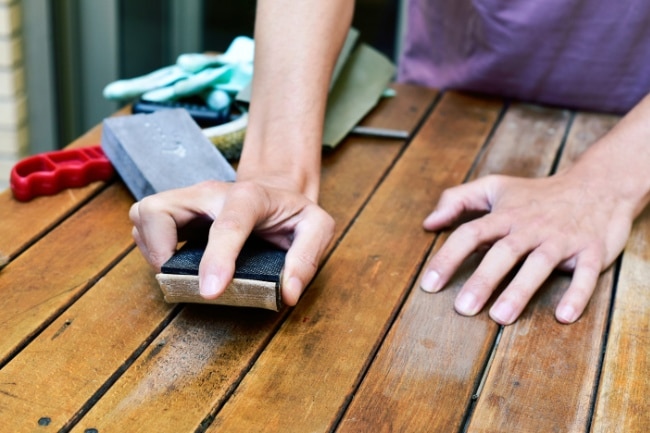
They’re ideal for smoothing rough surfaces, removing tool marks, and preparing wood for finishing. Their simplicity provides unparalleled control, enabling you to preserve the integrity of your piece. This simple tool is invaluable for achieving a quality finish on your woodworking projects, especially if you’re unfamiliar with power sanders.
Harnessing Hand Planes
Hand planes are the epitome of traditional woodworking. These tools shave thin slices from the wood surface, perfect for leveling out uneven areas, squaring edges, and even adding chamfers.
Mastering a hand planer requires patience and practice but offers a hands-on feel that’s hard to replicate with power tools. It’s an exercise in finesse, where the craftsman becomes intimately connected with the texture and grain of the wood.
A well-tuned hand plane is crucial for achieving flat, smooth surfaces on your woodworking projects. Hand planes come in various sizes and types, such as jack, smoothing, and jointer planes, each with a specific purpose.

For instance, a jack plane is excellent for flattening rough surfaces, while a smoothing plane helps refine the surface further. Properly setting up and using a hand plane ensures precision and efficiency in your work.
In addition to these tools, it’s essential to have a well-organized workspace where you can securely store your equipment and work on your projects. Properly setting up your workspace will make it easier to focus on honing your woodworking skills and creating beautiful, handcrafted pieces.
Joinery Hand tools
Pocket Hole Jigs
Pocket hole jigs are another great joinery tool for making your projects come together quickly and efficiently. With a pocket hole jig, you can drill angled holes into the wood, then use special screws to join the pieces. This is especially helpful for projects that require butt joints or right angles, such as cabinets and frames.
Some advantages of pocket hole jigs include the following:
- Fast assembly
- Easy alignment
- Strong, hidden joints
Just remember to choose the correct screws for the thickness of your wood and practice drilling pocket holes on scrap wood before you start your main project.
Doweling Jigs
Doweling jigs are particularly useful for:
- Creating edge-to-edge joints
- Joining end grain to long grain
- Strengthening corners
Always use a sharp drill bit, and choose dowels of the right size and material for your project. Practice on scrap wood to get confident with your doweling jig before starting your actual project.
Clamps
A key component of successful joinery is having the correct set of wood clamps. They secure your workpieces while cutting, gluing, or assembling, ensuring everything stays in place. Various clamps, such as bar clamps, pipe clamps, and C-clamps, are available on the market, so choose the ones best suited for your specific project requirements.

Consider these factors when selecting clamps:
- Clamping pressure
- Size and capacity
- Ease of use
Remember, there’s no such thing as too many clamps; using them correctly can make a difference in the quality of your woodworking projects.
Working with Hammers and Mallets
In woodworking, hammers and mallets aren’t just for driving nails. They also adjust your workpiece, drive chisels, and even help fit joinery. Each strike is a dialogue between the craftsman and the wood.
Power Up: Essential Power Tools for Woodworking
As a DIY enthusiast and self-taught woodworker, I’ve learned much about power tools and their roles in woodworking projects. In this section, let’s dive into the essential power tools you’ll need and how they can enhance your woodworking experience.
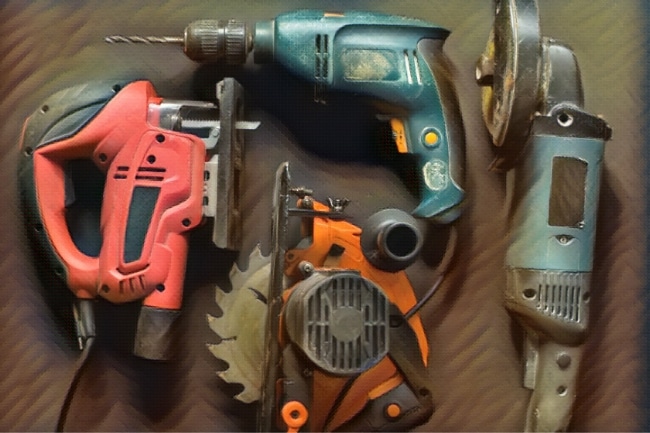
Power Saws: Taking Your Cuts to the Next Level
Circular Saws
A circular saw is an indispensable power tool in any woodworking shop. It is your go-to tool for making quick, straight cuts across boards and plywood, framing lumber and even hardwoods, and building DIY furniture. Equipped with a round, razor-sharp blade, they’re perfect for rough dimensioning, especially for larger lumber.
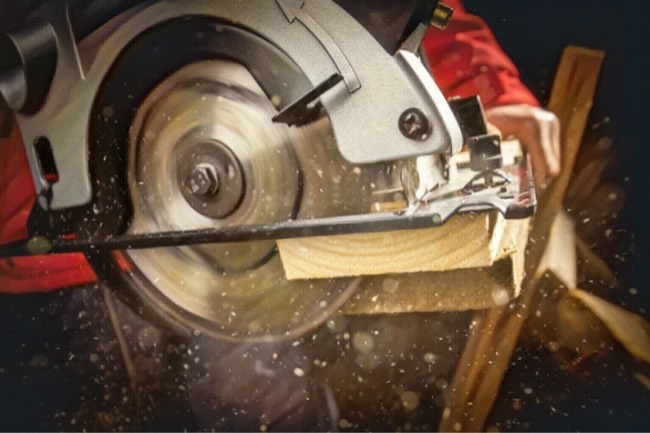
A circular saw can cut through various materials like plastic and metal with the right blade. Remember to correctly set the saw’s depth and use safety gear like goggles and hearing protection.
> Sidewinder Circular Saws:
Lightweight and compact, sidewinder circular saws (or inline saws) are great for most general purposes. The motor is located alongside the blade, making them well-balanced and easy to handle for straight cuts. They’re perfect for tasks like cutting plywood or other sheet goods.
> Worm Drive Circular Saws
If power is what you’re after, then worm-drive circular saws are the ones to beat. The motor is positioned behind the blade, providing higher torque and cutting capacity. This makes them ideal for heavy-duty tasks, like cutting through dense, thick hardwoods or wet lumber.
> Hypoid Circular Saws
Hypoid saws are a type of worm drive saw but with a sealed motor. This provides better cooling and requires less maintenance. They’re designed for heavy-duty applications and offer excellent durability, even in the most demanding conditions.
Each type of circular saw brings its own strengths to the table, so choose based on the requirements of your projects and the type of materials you typically work with.
Miter Saws
A miter saw will make your life easier when making accurate angle cuts. They’re perfect for creating frames, crown molding, or any other project that requires precision and consistency.
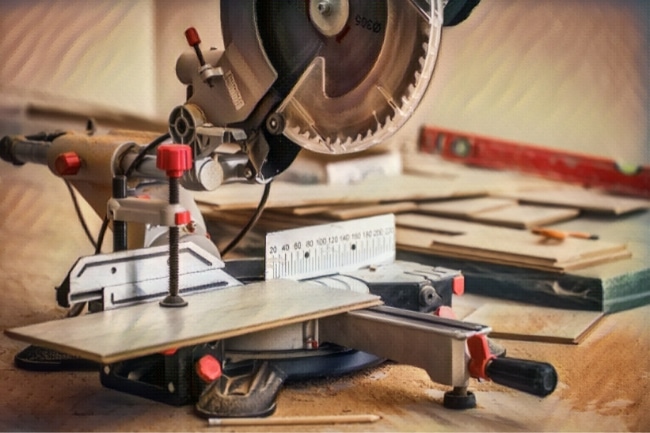
Although this power tool may not share the versatility of a circular saw, it excels in making accurate and repeatable cuts. Invest in a reliable miter saw with adjustable angles and a large cutting surface to make your woodworking projects go smoothly.
> Standard Miter Saws
These saws make crosscuts and miter cuts at various angles. They are especially useful for projects that require accurate angle cuts, such as picture frames, door frames, or window casings.
> Compound Miter Saws
Offering more versatility than standard miter saws, compound miter saws can pivot left or right for angled cuts and tilt horizontally in either a single direction or both(dual compound miter saws) for beveled cuts. This dual functionality allows you to make compound cuts in one pass, which is ideal for more complex constructions like crown molding.
> Sliding Compound Miter Saws
Adding another layer of functionality, sliding compound miter saws feature a movable arm that lets the blade cut wider boards, expanding the saw’s cutting capacity. They can make all the cuts that a compound miter saw can produce and handle larger materials.
Jigsaws: The Master of Curves and Complex Cuts

The jigsaw is perfect for curves and other more complicated shapes that can’t be tackled by any other saw. Use it for cutting out holes( any shape like circles, squares, rectangles, etc.) or even straight cuts if you don’t own a circular/table saw. Choose a jigsaw with variable speed settings to have greater control over your cut.
Bandsaws: The Go-To Tool for Resawing and More
Bandsaws are versatile and powerful tools characterized by their continuous, looping blade that cuts in one direction. They stand out in their ability to make both straight and curved cuts, offering a level of versatility that’s hard to match.
But where bandsaws truly shine is in resawing—slicing wood along its width to create thinner slabs—or for cutting thick materials, as the design allows for greater depth of cut compared to most other saws.
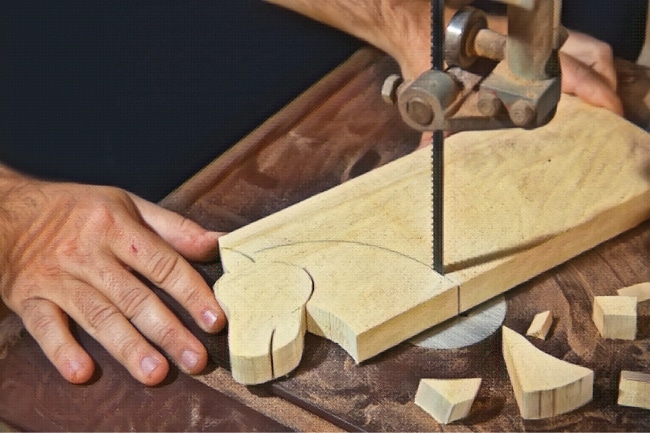
Bandsaws come in a variety of sizes, from small benchtop models to large floor-standing versions. The larger the bandsaw, the more powerful and capable it tends to be.
Whether you’re into fine woodworking, carpentry, or metalworking, a bandsaw is an indispensable addition to your tool arsenal. The variety of cuts it can make will open up new project possibilities and push your craft to new levels.
Scroll Saws: The Specialist for Intricate Designs
With their narrow, vertically oriented blades, scroll saws are the go-to tools for making intricate, precise cuts. Thanks to their unique blade design, they excel at creating curves and delicate patterns, even allowing for interior cutouts without an entry slot. If you’re into marquetry, intarsia, or any detailed woodworking requiring exact cuts, the scroll saw is your best ally.
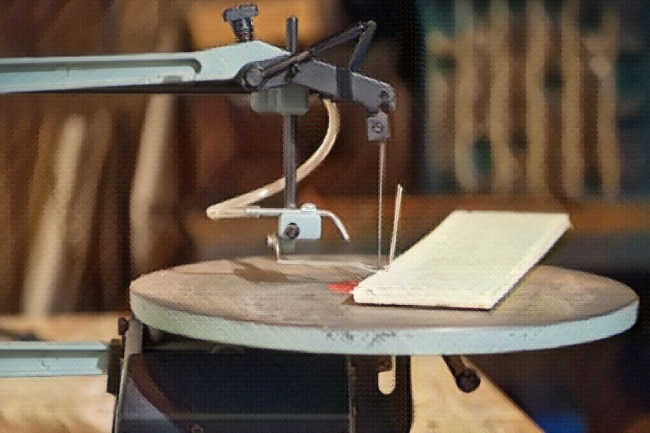
The functionality of a scroll saw can be compared to that of a jigsaw. However, scroll saws offer higher precision and control, making them especially suited for detailed, decorative, and complex patterns. They come in various throat sizes (distance from the back of the blade to the rear frame) that determine the workpiece size they can accommodate.
If you’re looking to add intricate details to your projects, the scroll saw is an indispensable tool. Its precise, clean cuts can elevate the level of artistry in your work and bring your most intricate designs to life.
Table Saws: The Heart of Your Workshop
If you’re serious about woodworking, a table saw is an absolute must-have in your arsenal. This powerhouse machine can easily rip, crosscut, and dado boards, making it an essential tool in any woodworking shop. However, given its size, planning and ensuring you have enough space to accommodate it is essential.
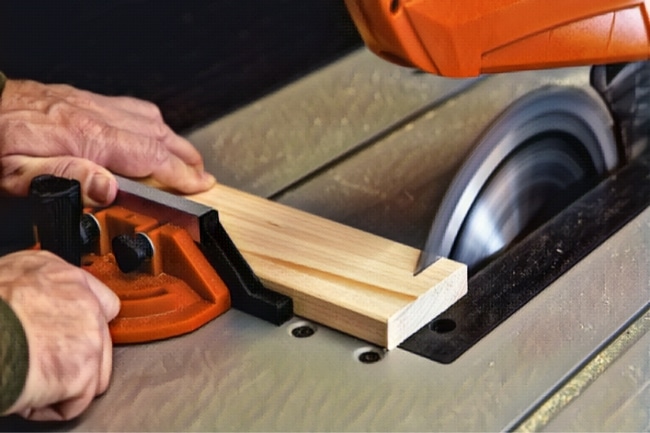
A quality fence system and a reliable miter gauge for precise and accurate cuts to get the most out of your table saw are crucial for more complex projects. Trust me, these simple additions will make all the difference in your woodworking projects, and you’ll be amazed at the level of precision you can achieve.
> Portable Table Saws
These are designed for easy transport and are ideal for job sites. They may lack some of the power and precision of larger models, but they’re perfect for DIYers and contractors who need a mobile solution.
> Contractor Table Saws
A great mix of power and portability, contractor table saws offer a good balance for those who need more capacity than portable models but still want some mobility. They have larger working surfaces and more powerful motors.
> Cabinet Table Saws
If power and accuracy are your top priorities, and you have the space, a cabinet table saw is the ultimate tool. With powerful motors and robust construction, these saws are built for precision and durability. They’re often the go-to choice for professional woodworkers.
> Hybrid Table Saws
As the name suggests, hybrid table saws blend the compact size of contractor saws with the power and dust control of cabinet saws. They’re designed for woodworkers who want cabinet-like performance but don’t have the space or budget for a full-size cabinet saw.
Drills and Drivers: More Than Just Holes
A versatile drill is essential for woodworking. From drilling holes to driving screws, this power tool has a range of applications. Consider getting a cordless drill for convenience, and invest in a good set of drill bits spanning various sizes and types to accommodate your diverse projects.

> Power Drills
Power drills are the quintessential power tools, quickly creating holes and driving screws. They offer both speed and torque control, making them versatile for a multitude of tasks.
> Impact Drivers
Impact drivers are heavy hitters. They deliver a strong, sudden rotational force and forward thrust, making them ideal for driving large screws and removing stubborn bolts.
> Drill Presses
For precision drilling, nothing beats a drill press. It ensures that every hole you drill is perfectly straight or at a preset angle.
Introducing Router Tools: The Versatile Craftsman’s Tool
If you want to add flair and finesse to your woodworking projects, then a router is an absolute game-changer. With this versatile tool, you can easily create decorative edges, joinery, and grooves in your workpiece. While tabletop and handheld models are available, as a beginner, a handheld router will likely be enough to suit your needs.
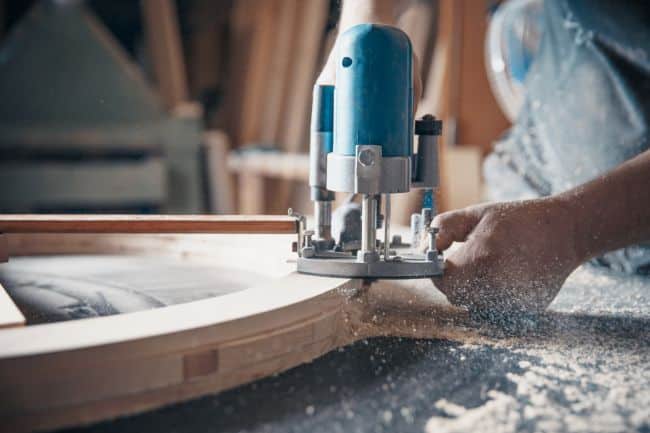
Buy the best quality set of router bits you can afford to get the most out of your router. With the right bits, you can take your projects to the next level and achieve precision and detail that will make them shine. Once you start using a router, you’ll wonder how you managed without one.
Sanders and Planers: Smoothing Things Out
A smooth finish is what separates a professional-looking piece from a DIY project. That’s where sanders come in—these power tools remove material and create smooth surfaces on wood. Start with a random orbit sander, as it balances power, speed, and ease of use. Be sure to keep a variety of sanding disks on hand, as different grits are essential for a smooth finish.
> Orbital Sanders: Mastering the Art of Finishing
Orbital sanders are the smoothing wizards. They, also known as finishing or sheet sanders, are handheld tools that are excellent for ultra-smooth sanding and final finishing touches. They work by moving the sanding pad in small circles, or “orbits,” giving you more control over the finish.
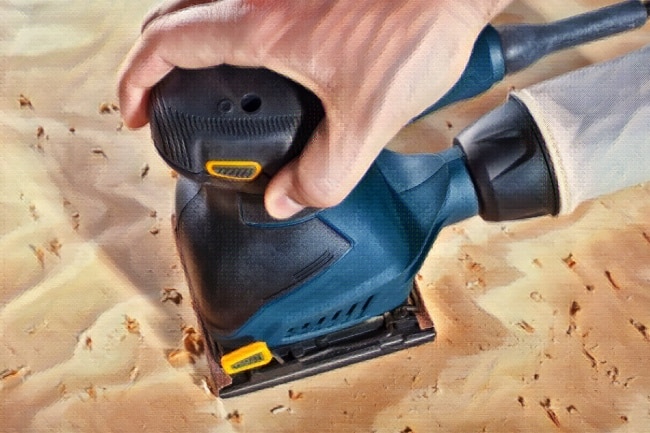
Orbital sanders are perfect for projects that require fine, detailed work or any time you need to sand in tight spaces. They’re less aggressive than belt or random orbital sanders, which makes them ideal for achieving smooth surfaces and preparing workpieces for painting or varnishing.
> Random Orbital Sanders: The Best of Both Worlds
Random orbital sanders combine the speed and aggressiveness of a belt sander with the control and finish quality of an orbital sander. They move in both an elliptical and spinning motion, ensuring that no single part of the abrasive material travels the same path twice. This results in a finer, swirl-free finish.
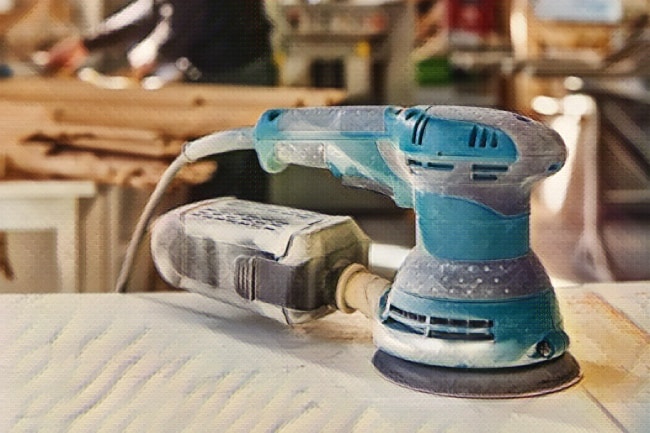
Random orbital sanders are excellent for both stock removal and ultra-smooth sanding. They can handle a wide range of tasks, from prepping new wood to stripping old paint and varnish. Moreover, you can adjust the tool with variable speed controls to match your task and material.
>Belt Sanders: Powerhouse for Rapid Material Removal
Belt sanders are true workhorses in the world of power tools. They utilize a continuous loop or “belt” of sandpaper for aggressive material removal, making them excellent for jobs like smoothing rough-sawn surfaces, removing old paint or varnish, and evening out large flat surfaces. A belt sander’s sheer power and speed can save you significant time on these large-scale projects.
>> Handheld Belt Sanders
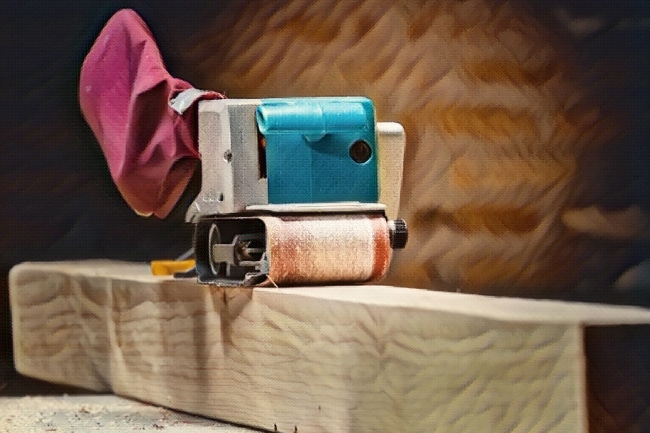
These portable power tools are commonly used to sand and smooth wooden surfaces. Handheld belt sanders are ideal for removing material quickly and efficiently over larger areas. Their portability makes them well-suited for on-site work and a variety of applications.
>>Stationary Belt Sanders
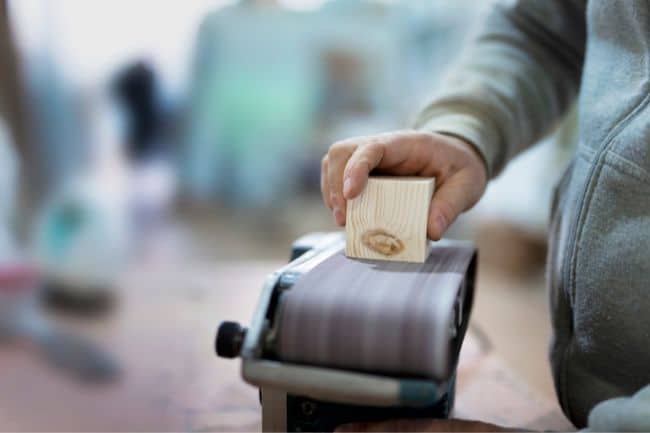
These tools are mounted to a bench or stand and are used for heavy-duty sanding tasks. The workpiece is brought to the stationary sander, allowing for a high level of control and precision. These sanders are great for shaping and finishing, especially when dealing with smaller pieces that need detailed work.
>> Combination Belt/Disc Sanders
Offering both a belt and disc sander in one unit, these tools provide the versatility of two sanding machines in one compact package. The belt sander handles longer and wider stock, while the disc sander is perfect for precise edge work and smaller pieces.
Electric Hand Planers: A Handy Tool for Flattening and Smoothing
Electric hand planers give you the precision of a traditional hand plane with the power and speed of a power tool. They are versatile and invaluable tools for any woodworker. Used to flatten, smooth, and remove wood from surfaces, allowing for precision and depth that would be challenging to achieve manually.
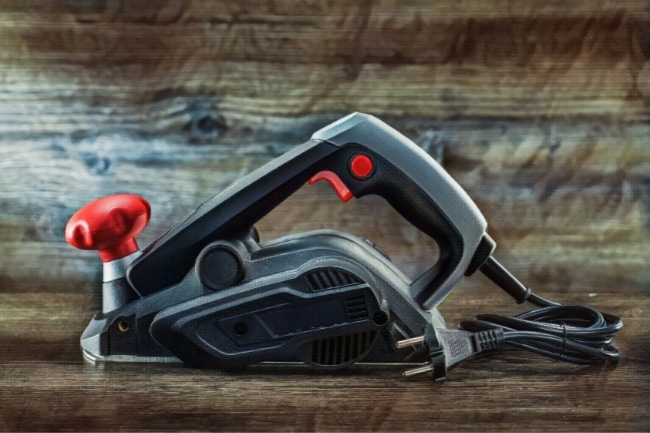
Whether fitting a door, squaring off timber, or simply smoothing out a rough piece of wood, the electric hand planers can be a real time-saver. They are excellent for quick dimensioning and surface smoothing.
> Corded Electric Hand Planers
These offer continuous power, making them ideal for extensive planing tasks. They tend to be more powerful than their cordless counterparts and are a reliable tool for any workshop.
> Cordless Electric Hand Planers
These offer the convenience of portability without the hassle of a cord. They’re perfect for on-site work and smaller projects, especially in places where an outlet might not be easily accessible. Remember to keep batteries charged for uninterrupted work.
Then there are thickness planers, also known as thicknessers, which are stationary woodworking machines used to trim boards to a consistent thickness and flatness across their length and width. Whether you’re preparing stock for a large project or want to repurpose old, rough-sawn lumber, a thickness planer can be an invaluable tool.
> Benchtop Thickness Planers
These are compact and portable, making them suitable for small to medium-sized workshops or job sites. Despite their size, they offer substantial power for handling various wood species and board sizes.
> Stationary Thickness Planers
These are large, heavy-duty machines intended for professional use in larger workshops. They’re capable of handling wider and longer boards and often include advanced features for precision and efficiency.
> Jointer-Planer Combos
A more advanced type of electric planer, these machines are stationary and are used to flatten and square up larger boards. They’re an excellent addition to any serious woodworking shop where precision and accuracy are crucial.
Joinery Power Tools
Joinery is an essential part of woodworking, and learning about the different tools that can help you achieve precise and robust connections is crucial. This section will discuss biscuit joiners, pocket hole jigs, doweling jigs, and clamps.
Biscuit Joiners
A biscuit joiner is a fantastic tool for creating solid and durable joints with minimal effort. This power tool cuts slots in the edges of wood pieces, allowing you to insert thin, oval-shaped wooden biscuits coated in glue. As the glue dries and swells the biscuits, it forms a tight joint that can withstand a lot of stress.
- Easy to use once you’ve learned the basics
- Creates strong, tight-fitting joints
- Suitable for various woodworking applications
Make sure to buy the right size biscuits for your joiner, and always test your cuts on scrap pieces of wood before working on your actual project.
Nailing the Basics: Introduction to Fastening Tools
Understanding Different Types of Nails and Screws
Nails and screws are the bonding agents of the woodworking world. Nails, with their sheer strength, are excellent for holding pieces together temporarily or when strength is not a primary concern. Screws, with their thread and tip design, provide robust, long-lasting bonds.

Power Nailers and Screwdrivers: When Efficiency Matters
Power nailers and screwdrivers bring a new level of efficiency and ease to woodworking, significantly reducing the time and effort required for fastening tasks. Whether you’re building furniture, installing trim, or putting up drywall, these power tools can make the job go faster and smoother.
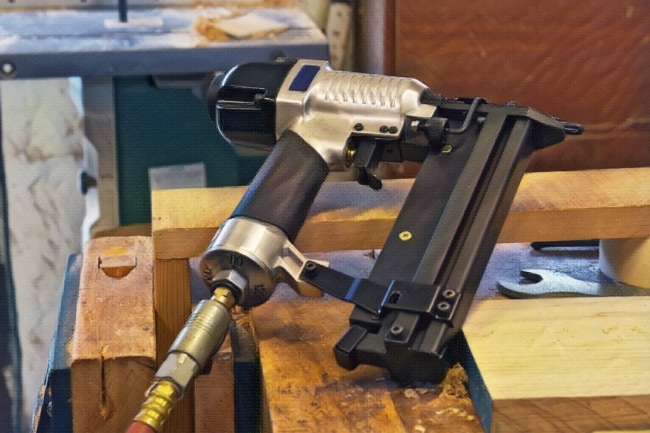
Nail Guns: Also known as nailers, these tools drive nails into wood or some other kind of material. They come in a variety of types, each suited for specific tasks:
Framing Nailers: These are the heaviest-duty nailers for large projects like framing houses, building decks, and constructing room additions.
Finish Nailers: These are more delicate than framing nailers and are used for smaller projects like attaching molding, trim, or cabinetry.
Brad Nailers: These are even smaller than finish nailers and are used for the lightest, most delicate trim work.
Staple Guns: These are used for fastening material to wood, such as fabric or insulation.

Power Screwdrivers: Power screwdrivers put the muscle behind the bit, ensuring you can drive screws in with precision and without straining your hand. They’re essential for tasks like assembling furniture, installing cabinets, and securing drywall.
Corded Screwdrivers: These provide consistent power for long periods of use, making them ideal for larger projects or professional use.
Cordless Screwdrivers: These offer the convenience of portability, making them a popular choice for household tasks and on-the-go jobs.
Impact Drivers: These are a type of power screwdriver that delivers more torque for driving large screws or removing stubborn, over-torqued screws.
Building Your Own Woodworking Toolkit

Assessing Your Woodworking Needs and Goals
Your toolkit should mirror your woodworking ambitions. The scale and complexity of your projects will dictate the tools you need. Whether you’re building a birdhouse or crafting fine furniture, every tool should serve a purpose in your workshop.
Setting a Budget for Your Woodworking Toolkit
Quality tools are an investment in your craft. Setting a budget that balances cost and quality will ensure you get the best value. Remember, it’s better to slowly accumulate high-quality tools than to buy a low-quality set all at once.
Tips on Choosing High-Quality Tools
Don’t be swayed solely by brand names or glossy ads when selecting tools. Look for durability, user comfort, and performance. Seek advice from experienced woodworkers, read reviews, and, if possible, test the tool before purchase.
Conclusion: Embarking on Your Woodworking Journey
Selecting the appropriate tools for your projects can make all the difference in the outcome of your work. When starting out, investing in some basic hand tools such as saws, hammers, and chisels is essential, as these will be fundamental in most woodworking endeavors.
By gaining familiarity with these tools, you’re building the foundations of your woodworking expertise.
You’ll also want to familiarize yourself with power tools like drills, circular saws, and jigsaws, especially as your skills and project complexity grows. Over the years, I’ve found that focusing on quality over quantity is key to building a reliable, efficient toolkit that will help ensure success in your woodworking adventures.
The Path Forward: Continual Learning and Mastering Your Craft
Woodworking is a journey of continual learning. As you gain confidence with basic tools, you can explore more advanced tools and techniques. Remember, the goal isn’t just to accumulate tools but to master their use in creating your woodworking projects.
As you progress in your woodworking journey, remember that patience and practice are crucial for success. Take the time to learn new techniques, like joinery and finishing methods, and don’t be afraid to ask for advice from others in the woodworking community.
By embracing the learning process and consistently improving your skills, you’ll be well on your way to creating stunning furniture, upcycled decor, and more.
Final Thoughts: Embrace the Woodworking Adventure
Woodworking is an exciting adventure that combines creativity, skill, and the satisfaction of crafting something with your own hands. Remember to enjoy the process as you build your toolkit and hone your skills. The joy of woodworking comes not just from the finished piece but from the journey of transformation from simple lumber to a crafted masterpiece. Embrace the journey and let your woodworking adventure begin!
Subscribe To My FREE DIY Newsletter!
Stay in touch and receive things like updates, special offers, new projects, tips, gear reviews, and more. No spam, promise!
By entering your email address, you agree to get an email newsletter from UpcycleThisDIYThat. I’ll respect your privacy, and you can unsubscribe at any time. For more details, review our Privacy Policy.




